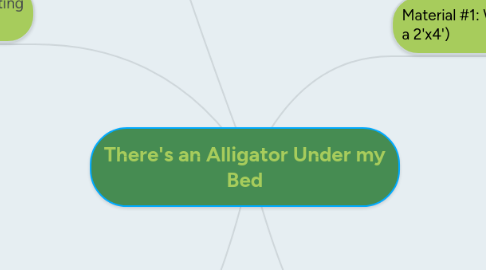
1. Material #1: Wood Beams (Such as a 2'x4')
1.1. Measuring Lengths - Provide Children with standard and non standard measuring tools, clip boards and writing utensils to encourage children to document their findings
1.1.1. Comminication, Language and Literacy - 3.12 Understanding the Orientation and Familiar Conventions of Print (ELECT, 2014, p.45)
1.1.2. Cognition - 4.19 Measuring Lengths, Weight and Capacity, Temperature, Time and Money (ELECT, 2014, p. 81)
1.2. "Walking Across Alligator Swamp" - Encourage children to practice walking and balancing on the wood beems
1.2.1. Physical - 5.1 Increasing Levels of Activity, Endurance and in Variation in Types of Activities and Skills (ELECT, 2014, p.42)
1.2.2. Emotional - 2.6 Positive Attitude Towards Learning (ELECT, 2014, p.41)
1.3. "Slithering Gators" - Set up wood beams in order to encourage children to "slither" under and hop over
1.3.1. Physical - 5.2 Gross Motor Skills (ELECT, 2014, p.52)
1.3.2. Social - 1.6 Co-operating (ELECT, 2014, p.38)
1.3.3. Emotional - 2.1 Self-Concept (ELECT, 2015, p.40)
2. Material #2: Real Fruits and Vegetables
2.1. Classifying Food Groups - Provide children with different containers with pictures and words of different food groups
2.1.1. Cognition - 4.10 Classifying (ELECT, 2014, p.48)
2.1.2. Comminication, Laguage and Literacy - 3.3 Vocabulary (ELECT, 2014, p.42)
2.2. Painting with Food - Provide children with paper and paint
2.2.1. Communication, Language and Literacy - 3.5 Using Descriptive Language to Explore, Explain and Extend (ELECT, 2014, p.43)
2.2.2. Cognition - 4.8 Communicating Findings (ELECT, 2014, p.48)
2.3. "Farmers Market" Dramatic Play - Set up a "farmers market" in the dramatic area. Include, baskets, pictures and prices for each food item, fake currency, and a cash box.
2.3.1. Cognition - 4.3 Representation (ELECT, 2014, p.46)
2.3.2. Communication, Language and Literacy - 3.4 Conversing with Peers and Adults (ELECT, 2014, p.42)
3. Material #3: Rubber Alligatos
3.1. Alligator Sensory Bin - Add sand, water, sticks, greenery and rocks into the sensory area to encourage children to explore an alligator's habitat
3.1.1. Cognition - 4.3 Representation (ELECT, 2014, p.46)
3.1.2. Cognition - 4.5 Observing (ELECT, 2014, p.47)
3.2. Opportunity to Discuss Alligators - Provide visuals and props children can explore when talking about alligators
3.2.1. Communication Language and Literacy - 3.3 Vocabulary (ELECT, 2014, p.42)
3.2.2. Communication, Language and Literacy - 3.6 Listening to Others (ELECT, 2014, p.43)
3.3. Counting Gators - Provide children with a number of small rubber alligators. Have several different bowls/containers with a number attached. Encourage children to fill the bowl/container according to the number attached with the rubber alligators.
3.3.1. Cognition 4.10 Classifying (ELECT, 2014, p.48)
3.3.2. Cognition - 4.12 Counting (ELECT, 2014, p.49)
4. Material #5: Large Cardboard Box
4.1. "What is in the Fridge?" - Set up cardboard box as a fridge, use shelves and containers to place food in. Label shelves and containers with corresponding food items
4.1.1. Cognition - 4.3 Representation (ELECT, 2014, p.46)
4.1.2. Social - 1.1 Making Friends (ELECT, 2014, p.37)
4.2. "Whats Under the Bed?" - Set up cardboard box as a bed and place different objects under the "bed" for children to explore
4.2.1. Cognition - 4.22 Using Spatial Relations, Directions and maps (ELECT, 2014, p.51)
4.2.2. Communication, Language and Literacy - 3.9 Retelling Stories (ELECT, 2014, p. 44)
4.3. Making an Alligator Habitat - Provide Children with the opportunity to gather natural materials (Grass, branches, rocks, leaves, dirt, sand, mud) from the outdoors to create an alligator habitat
4.3.1. Cognition - 4.3 Representation (ELECT, 2014, p.46)
4.3.2. Communication, Language and Literacy - Using Descriptive Language to Explain, Explore and Extend (ELECT, 2014, p.43)
5. Materiel #4: Magazines (subjecting in food and wild life)
5.1. Making Grocery Lists - Provide children with grocery magazines/flyers to encourage the children to create a grocery list. Scissors will also be available to the children.
5.1.1. Communication, Language and Literacy - 3.12 Understanding of Orientation and Familiar Conventions of Print (ELECT, 2014, p.45)
5.1.2. Communication, Language and Literacy - 3.13 Matching Spoken Words with Written Ones (ELECT, 2014, p.45)
5.2. What Do Alligators Like to Eat? - Provide children with magizines/flyers with pictures of food encourage children to identify what they think alligators may eat. Scissors will also be available to children.
5.2.1. Cognition - 4.4 Questioning (ELECT, 2014, p.47)
5.2.2. Physical - 5.3 Fine Motor Skills; Drawing (ELECT, 2014, p.54)
5.3. 'A' is for Alligator - Provide children with upper and lower case visuals of the letter 'A' Underline or bold the 'A's in Alligator. Children will be encourage to go through the magazines and cut out the letter "A"
5.3.1. Communication, Language and Literacy - 3.11 Letter Recognition (ELECT, 2014, p.44)
5.3.2. Communication, Language and Literacy - 3.10 Phonological Awareness (ELECT, 2014, p.44)
